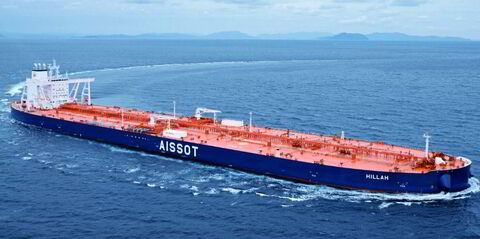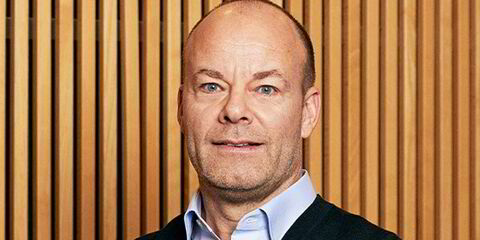John Fredriksen launched a fresh LNG gambit this year by putting his gas shipping interests into Flex LNG — and it looks like he means business.
In the first six months of 2017, Flex has added newbuilding and chartered tonnage, beefing up its fleet to 10 LNG carriers.
The UK-headquartered and Oslo-listed outfit has also brought in experienced LNG industry hand Jon Cook as its new chief executive.
At the turn of the year, Flex surprised the market by taking a succession of four modern LNG carriers on charter hire for periods of six months, with options to extend by a similar period, at a time when market rates were low.
Cook says the prime rationale for chartering in the quartet was to allow Flex to become operational, put internal procedures and processes in place, and establish a reputation with the various charterers before its first LNG newbuildings come online next year.
The strategy clearly worked for one vessel, which has been sublet for a year to German trader Uniper. The other three have been trading spot.
Cook admits utilisation has been a challenge and that maybe Flex could have taken fewer vessels. But he added: “We looked at it as having a few ships to give us more flexibility.”
Flex takes delivery of its first two newbuildings in January when DSME hands over two M-type, electronically controlled, gas-injection (ME-GI) LNG carriers. The 174,000-cbm newbuildings are listed on databases as the Flex Endeavour and Flex Enterprise.
In May and June 2018, Samsung Heavy Industries will hand over two similar newbuildings. The berth slots for these ships started life as those for the so-called “M-Flex LNG Producers” that were contracted around 10 years ago when the company was under different management.
Another pair of sister vessels, which were ordered this year on favourable pricing terms as part of Fredriksen's negotiations with the yard on VLCC resales, will follow from DSME in June and August 2019.
Last week, Flex said it was looking to move its listing up to the main Oslo Bors from the Oslo Axess board for companies with less history. In April, it was reported to be carrying out a private placement of shares aimed at raising NOK 1.1bn ($125m) to fund newbuildings.
“Looking at the market fundamentals and how we see the demand for LNG carriers developing over the next couple to three years, we believe that the market will become in balance towards the end of 2018 and into 2019,” Cook said.
However, he adds that demand may pick up earlier if sentiment starts to shift.
Mix of charters
The chief executive says Flex’s goal is to fix in a portfolio fashion with some ships chartered long term for periods of seven to 10 years and others available for shorter term or spot business.
“As we see the market improve, we may fix out longer term as rates improve,” he said.
Cook is clear that the intention is to grow the business. As the company layers in term charters, he says it may order more vessels.
He hints that Flex’s appetite for speculative ordering may be sated for this year but says future newbuildings are likely to be dependent on how the market develops.
However, Cook is also mindful that the earliest shipyard LNG berths currently available are for delivery dates at the end of 2019 or into early 2020. He reveals the company is already seeing requirements for deliveries in 2020 — business that could be fulfilled by new orders.
The new chief executive describes the 2020 era as “coming into focus” as those with long-term supply commitments who have not covered the shipping yet are seeing that the incoming LNG production is on schedule.
Cook says Flex is holding discussions with various project and portfolio counterparties on its incoming newbuildings. He adds that the terms vary from one year to seven, based on required deliveries in 2018 to 2020.
But he admits it is hard to assess how the rate picture will look for LNG carriers over the longer-period business.
“We believe the rates will improve," he said. "It is just a matter of when. The charterers have been living in an environment of being able to achieve very low rates and a lot of flexibility. That’s going to change. Some of them know it. Some are still hoping to do things in today’s environment, and there are still a lot of ships available.”
He says sentiment is starting to shift — there are more enquiries for fixing forward and for period business from parties that would previously have been happy to remain in the spot market — but it has not yet moved.
Aside from preparing to take on and work with its six newbuildings, the team at Flex is also starting to consider whether to take up the optional six-month hire period on its chartered-in tonnage.
“We are into the phase where we are evaluating our options,” Cook said.
He says part of the rationale on the chartered tonnage is to give some flexibility with the delivery and chartering of the newbuildings, adding that the time-charter vessels can be used initially and the newbuildings swapped in.
"The market has been very receptive to us coming into the space with sublet vessels," he said. "And we have transacted with most of the big charterers."
Cook is also conscious that Flex’s chartering moves have allowed the company to build a relationship with those ships' counterparties, such as Woodside and Gazprom Marketing & Trading.
“Hopefully, we will count them as customers down the road,” he said.
Cook adds that Flex will continue to look at additional opportunities to charter in vessels next year and beyond if it makes sense.
“There may still be a place for that even when we have our newbuilds on the water,” he said. “It’s a purely opportunistic approach.”
Cook anticipates that Flex will fix some of its newbuildings prior to delivery but wants to have a couple of ships open and available in the spot and short-term market going into 2019.
“That’s when the landscape will be a bit different,” he said.
He adds that Flex is also open to looking at smaller ship sizes, if that is the requirement, and stresses that the company is “not wedded” to ME-GI propulsion. It is happy to look at other technologies if that is the brief.
“We’re always flexible," he said. "It’s in our name. You have to be. It is really what the customers look for.”
Flex LNG's newbuilding orderbook
| Hull No | Shipyard | Size (in cbm) | Delivery |
| 2447 | DSME | 174,000 | January 2018 |
| 2448 | DSME | 174,000 | January 2018 |
| 2107 | SHI | 174,000 | May 2018 |
| 2108 | SHI | 174,000 | June 2018 |
| TBA | DSME | 174,000 | June 2019 |
| TBA | DSME | 174,000 | August 2019 |
Flex LNG's chartered tonnage
| Ship name | Size (in cbm) | Delivery | Trading |
| Energy Atlantic | 159,924 | 2015 | spot |
| Pskov | 170,200 | 2014 | spot |
| Woodside Rees Withers | 174,501 | 2016 | relet to Uniper |
| Yenisei River | 155,000 | 2013 | spot |



